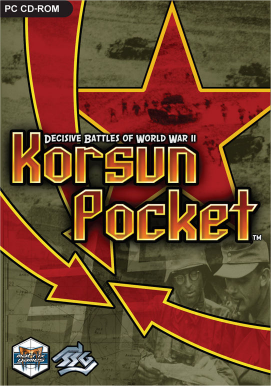| Korsun Pocket is the long awaited sequel to The Ardennes
Offensive in the Decisive Battles system. Korsun Pocket uses a greatly
improved version of the Ardennes Offensive engine to recreate the desperate
German attempt to escape encirclement on the Russian Front early in 1944.
The battle is a tense and exciting struggle, with neither side having
a decisive advantage, as the Russians struggle to form the pocket, then
try to resist successive German rescue efforts and last ditch attempts
at breakout.
PC Gamer gave Korsun Pocket 93% and an Editor’s
Choice Award, calling it "The best wargame ever
made for the PC. A monumental achievement in Game Design”.
Computer Gaming World gave Korsun Pocket 5/5 and an
Editor’s Choice Award.
GAME FEATURES
Automatic Play by Email support
Enhanced AI routines
More detailed unit data
Better unit graphics
Complete Tutorial explains everything for new players
Detailed game manual
Complete Map, Unit, Scenario and AI Editor |
|
AVAILABILITY
In North America: www.matrixgames.com
In Europe: www.justplaynow.com
SCREEN SHOTS
Click here for Screen Shots
from Korsun Pocket.
REVIEWS
Korsun Pocket Review at the Game
Spot
Korsun Pocket Review at the Wargamer
Korsun Pocket Review at the Game
Zone
HISTORY
For most of 1943 the German army in Russia had slowly fallen back under successive
hammer blows from the Russians. By January 1944 the Dnieper River had been crossed
and Kiev had been liberated. South of the Ukrainian capital the Germans still
held one stretch of the Dnieper, between the cities of Kanev and Cherkassy.
The Germans knew that an attack was imminent. In early January the Russians
launched several small attacks around the flanks of the bulge. South of Cherkassy,
General Konev had massed four armies and there were slightly fewer men north
of the bulge under General Vatutin.
On January 25th the offensive began. Three days later the Soviet spearheads
met in the town of Zvenigorodka and two German corps were encircled in a pocket
centered on the town and airfield of Korsun. The logical response was for the
encircled units to attempt a break out to the southwest, but Hitler was rarely
logical. Instead he envisaged a massive stroke north along the Dnieper to Kiev.
It would have been a good plan if the Germans had possessed the forces to carry
it out, but they simply didn’t.
Initially the German problem was more serious than simply rescuing the 56,000
men inside the pocket. There was a gaping hole in their line, one that fortuitously,
General Konev didn’t exploit. Instead minefields were laid in the south
against any German attempt to break into the pocket and the Russians settled
down to a siege.
Meanwhile the Germans were gathering forces for a counterattack. On February
4th, two Panzer divisions with attached heavy panzer units attacked towards
the pocket. However, on February 6th the skies cleared for the Soviet airforce
and more seriously for the panzers, the ground melted into a sea of mud. The
next day the attack was stopped with twenty miles between the relief force and
the Korsun Pocket.
As preparations were made for fresh relief attempts, the Germans inside the
pocket slowly retreated from the Dnieper and made their own attacks in the southwest.
On February 11th, with the ground once again frozen, four panzer divisions of
the III Panzer Corps launched a fresh attack northeast towards Korsun. The key
town of Lisyanka was captured and the objective became Hill 239 from which observers
could see into the pocket. For two days German and Soviet armor fought over
this hill. Finally the Germans had to admit their inability to capture Hill
239 and the second relief attempt failed.
Inside the pocket the supply situation was becoming desperate. General Stemmerman
inside the pocket realized that he had to break out. On February 13th he abandoned
the airfield at Korsun in order to reduce the size of the pocket and free up
men to attack to the southwest and the relief force. Shanderovka, six miles
east of Hill 239 was captured. Finally, on February 16th, without consulting
Hitler, Generalfeldmarschall von Manstein ordered the breakout from the pocket
to begin at 11PM. Three spearheads were organized and all papers were destroyed
in preparation for the move.
At 11PM in falling snow the breakout began. The Germans steadily ground southwest,
under constant Russian shelling and attacks by tanks that suddenly found the
pocket empty. Successfully breaking through the positions in front of them the
Germans eventually ran into Soviet trenches facing southwest. A vicious battle
began. As dawn broke on February 17th the Russians saw a German column stretching
from Hill 239 to Shanderovka. Their response was immediate and brutal. Attacks
were launched from all directions and the German retreat became a rout.
While the III Panzer Corps attacked Hill 239, 20,000 others had reached the
Gniloy Tikich River, two miles to the south. The river was normally a sluggish
stream, but with the intermittent thaw, it was a freezing torrent. Thousands
of men who had made it as far as the river, perished while trying to swim across.
Others who waited on the northeast bank were killed by Russian artillery fire.
Later on the 17th elements of 1st Panzer Division, alerted by half frozen swimmers
made it to the river and managed to rescue at least 10,000 men.
Of the 56,000 men trapped in the pocket about 30,000 were lost, as was the
equipment of six divisions. It was another pointless battle that the Germans
never should have fought and which they could ill afford.
